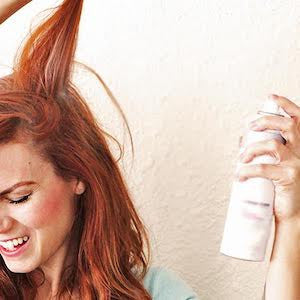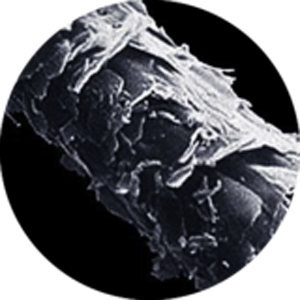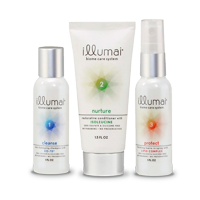How To Use Dry Shampoo - What You Should Know

More and more people are turning to dry shampoos, curious about how best to use them safely and effectively.
Dry shampoo is popular with people in a hurry -- especially those trying to preserve a great hair day or hoping to quickly make themselves presentable after a sweaty workout. It's a popular time-saving hack, that's for sure.
But what is dry shampoo really? And how should it best be used?
How Does Dry Shampoo Work?
Let’s start with the basics. Traditional shampoos were originally designed to cleanse the scalp as well as the hair. To keep your hair and scalp biome healthy, a regular removal of dirt, excess oils, dead skin and other contaminants is important. Dry shampoo is meant to do the same job, but instead of detergent, water and conditioner, it uses three different components: a propellant, an absorbent and an abrasive.
The propellent blows the other ingredients into the hair, distributing them evenly, often targeting an area near the roots where excess oiliness starts. The absorbents blot up the excess oils. The abrasives act like little scouring pads; they literally knock some of the dirt and oil off the hair so that the absorbents can mop them up.
All the ingredients, after capturing some of the dirt and oil, are then brushed out -- or at least most of them are brushed out. Dry shampoos always leave a residue. And they don’t do anything for scalp health.
Dry Shampoo Ingredients – Are they Safe?
The most common propellants used are butane, isobutene, propane or alcohol. They are volatile organic compounds (VOCs) and are flammable. Avoid inhaling them. And avoid open flames, because - like hairspray - in the presence of an open flame, spraying dry shampoo becomes a blowtorch!
The most popular active absorbents and abrasives are aluminum starch or silica. They mop up the moisture and oily films and scour off some of the dirt that covers the hair.
Inhaling the ingredients of a dry shampoo such as talc (magnesium silicate), silica (silicon dioxide, aka sand), cornstarch or aluminum starch is NOT good for you, especially if you have medical conditions that involve the lungs, such as asthma. Inhalation of cornstarch has been scientifically linked to airway inflammation, which can cause tissue damage (1). When inhaled, cornstarch also causes adhesions, and your body can have a severe inflammatory reaction that results in scarring. (2) Inhalation of silica can lead to silicosis, which can cause permanent lung damage. (3) And talc is even worse. (4)
Is Dry Shampoo Good for Your Hair?
Dry shampoo might help you get in more frequent workouts while keeping your style in place -- but use with care. The abrasives will sandblast the surface of your hair and scalp. The grittiness of the starch or silica physically wears away the surface of the hair shaft. Regular use can weaken the hair and cuticle, making your hair more brittle and frizz-prone. Also, similar to cleaning your hands with powder or sand, over time the hair may become dry and the scalp irritated.
No matter how hard you brush the dry shampoo out, it leaves a residue often described as a matte finish on your hair. Small clumps of absorbents remain on the scalp, roots and hair, causing irritation, odor and a gritty feeling. Let’s face it -- a dry shampoo does not get you clean. Yes, it soaks up some excess oils and is a great stopgap when you can’t wash. But don’t over-do it!
Last, you may have considered making up your own DIY dry shampoo, using baby powder, talc, cornstarch, baking soda or other common ingredients. This is not a good idea. First, without the propellant, it’s very difficult to get those small particles evenly distributed on scalp and roots, where excess oils first appear. Second, these are absorbents only -- and without the abrasives, they will tend to clump and leave a pesky residue. Last, and most important, they are not good for you: baking soda, can really irritate the scalp. And baby powder and cornstarch, if inhaled, can damage the lungs.
How Often Should I Use Dry Shampoo?
Every body is different: some can use a dry shampoo only once between shampoos. Others can get 2 or 3 uses -- and sometimes a bit more if you can tolerate the residue. The real answer is “as often as you need to and can deal with the imperfect results.”
If you use a non-ionic and sulfate-free shampoo, you won’t need to use dry shampoo so often; with a balanced biome and healthy scalp and hair, strands are naturally less porous and stay fresher longer.
Dry Shampoo Alternatives
A healthy, balanced biome is really the best answer to great hair. Some other recommendations from beauty professionals include:
- NoPoo: There are some health and beauty benefits to shampooing less frequently, especially if you are using standard hair care products containing sulfates, silicones and parabens. See “The No Poo Method: What You Need to Know” to learn more.
- Brush it Out: If you’re running short on time, you can trade washes for brushing your hair. It’s important to continue to remove dirt, dead skin and other contaminants from your hair and scalp, which you normally do when you shampoo. But brushing the hair along the entire hair shaft can bring out shine and deal with excess oil by not allowing sebum (hair oil) to concentrate at the scalp. That’s where brushing with a soft bristle brush comes in. Brushing instead of shampooing loosens oil and dirt buildup and distributes naturally produced oils all along your hair.
- Rinse Only: If you really sweat during a workout, don’t think you need to shampoo, especially if your hair was recently cleaned. A vigorous rinsing is all that it may need.
Summary: Dry Shampoo Tips
If you do use a dry shampoo remember these tips:
- Do not inhale -- the ingredients are not good for your lungs!
- Use sparingly; minimize the abrasive impact on hair and scalp -- it can damage the hair.
- Stay away from open flames -- propellants are flammable! Be sure to shampoo when you can -- it really is the better cleansing method.
- Avoid DIY remedies like baby powder, talc, cornstarch or baking soda.
Dry shampoo is a godsend when you literally have no time to shampoo. It can be especially valuable when you don’t want a sweaty workout to interfere with a great hair day or when you want to preserve a well-done blowout. But, remember, it’s a stopgap. Root-deep, vibrant hair always begins with an unclogged and fully intact hair and scalp -- a healthy biome. Keep it clean while preserving the brilliant system nature gave you. If you do, your hair and scalp will be healthy and wonderfully beautiful.
Footnotes
- Grunewald J, Eklund A, Katchar K et al. Lung accumulations of eosinophil granulocytes after exposure to cornstarch glove powder. Eur Respir J. 2003;21(4):646-51.
- Deroian E, Moss R, Pfister JI, et al. Surgical gloves: Is it time for a change? (Pfiedler Enterprises website.)
- American Lung Association, “Learn About Silicosis”
- American Cancer Society, “Talcum Powder and Cancer”
Learn More . . .

Detox Your Locks!

The No Poo Method: What You Need to Know


